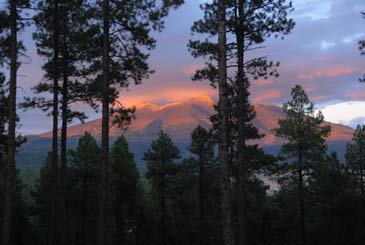The American Southwest is generally thought of as an arid region with expanses of deserts that are interrupted only by cities such as Phoenix, Tucson, and Albuquerque. This image of aridity has some truth, but the region also has cool, moist montane areas, namely the upper-elevation plateaus and mountains.
Introduction

Betty Huffman
These upper elevation plateaus and mountains have forests of pines (Pinus spp.), Douglas-fir (Pseudotsuga menziesii), firs (Abies spp.), spruces (Picea spp.), and quaking aspen (Populus tremuloides)—trees more often associated with the mountains of Colorado, Wyoming, and Montana. The montane areas of the American Southwest also have grasslands, shrublands, and—on the highest peaks—alpine tundra.
Montane forests cover only about 8% of the combined areas of Arizona and New Mexico, but they are important in a variety of ways. Ecologically, they are part of the impressive biological diversity of the region, providing unique habitat in a generally arid region. Economically, they have been major sources of timber, livestock forage, and water, as well as sites for outdoor recreation and tourism. Aesthetically, they include some of the more impressive scenery of the Southwest.
Distribution
The montane forests of the American Southwest are limited to upper-elevation plateaus and mountains and therefore have a discontinuous distribution. Some areas are extensive, including the southernmost portions of the Rocky Mountains in northern New Mexico and a band ranging from west-central New Mexico to the region of Flagstaff, Arizona. Smaller areas are more numerous and include the Santa Catalina and Pinaleño Mountains in southern Arizona and the Animas Mountains of southwestern New Mexico, which are called “sky islands” because of the isolation of these upper-elevation areas in an expanse of lowland desert. The easternmost montane forest of the American Southwest occurs in the Guadalupe Mountains of western Texas and adjacent New Mexico.
The distributions of species that characterize today’s montane forests have changed numerous times in response to climate. Montane species were able to respond quickly and effectively to past climate changes because they generally moved only short distances up or down slope, depending on whether the climate was warming or cooling. In contrast, lowland species had to migrate long distances north or south, sometimes through areas interrupted by unfavorable habitat. Therefore, mountains provided refuges for species adversely affected by climate change and served as sources of species benefiting from climate change. Paleoecologists have determined that species migrated individually rather than in assemblages or communities (e.g., Cole 1985). Therefore, montane forests of the geologic past differed in species composition from today’s forests.
Part of a series of articles titled Montane Forests of the Southwest.
Last updated: October 21, 2020
